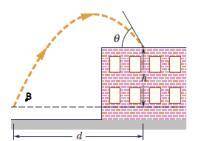
In fig. 4-41, a ball is thrown up onto a roof, landing 4.00 s later at height h 20.0 m above the release level. the ball’s path just before landing is angled at u 60.0° with the roof. (a) find the horizontal dis- tance d it travels. (see the hint to problem 39.) what are the (b) magnitude and (c) angle (relative to the horizontal) of the ball’s initial velocity?

Answers: 1


Other questions on the subject: Physics

Physics, 21.06.2019 14:10, Lianabel0517
Ok i am attempting to my niece attach a galvanized wire (like a tether for a dog) at the corner of two fences, making a tightwire if you will and we drilled a hole in a softball and she hits it. the ? and problem is that we can not get the wire taunt enough where it doesnt sag after hitting the ball once, and the wire sags and wobbbles. its a 15 ft rubber covered galvanized wire and one can adjust the length of the placing of the wire by having it make the corner of 2 fences become a it can be adjusted, however, with all our human strength and pliers we could not make it taunt as possible. is there anything other that attaching it to a car to do this. sorry abt the length but it would mean the world to my niece if i could solve this came up with the entire idea herself, and she is 14 and paid for the wire and did as much work as i did drilling a hole through a softball wide enough for attaching piece at each end of the wire that clips on to the fence. . any ideas welcome if serious. but awesome if it is a fact. much obliged. bucky bukowski buckman
Answers: 3

Physics, 22.06.2019 00:00, tsupreme
1134567 a jet with mass m = 1.1 ă— 105 kg jet accelerates down the runway for takeoff at 2 m/s2. 1) what is the net horizontal force on the airplane as it accelerates for takeoff? 2.2*10^5 n your submissions: 2.2*10^5 computed value: 220000submitted: saturday, january 26 at 2: 41 pm feedback: correct! 2) what is the net vertical force on the airplane as it accelerates for takeoff? 0 n your submissions: 0 computed value: 0submitted: saturday, january 26 at 2: 41 pm feedback: correct! 3) once off the ground, the plane climbs upward for 20 seconds. during this time, the vertical speed increases from zero to 21 m/s, while the horizontal speed increases from 80 m/s to 95 m/s. what is the net horizontal force on the airplane as it climbs upward? n 4) what is the net vertical force on the airplane as it climbs upward? n 5) after reaching cruising altitude, the plane levels off, keeping the horizontal speed constant, but smoothly reducing the vertical speed to zero, in 13 seconds. what is the net horizontal force on the airplane as it levels off? n 6) what is the net vertical force on the airplane as it levels off?
Answers: 1

Physics, 22.06.2019 00:20, alyvia05
Suppose that an electromagnetic wave which is linearly polarized along the x−axis is propagating in vacuum along the z−axis. the wave is incident on a conductor which is placed at z > 0 region of the space. the conductor has conductivity σ, magnetic permeability µ and electric permittivity ε. (a) find the characteristic time for the free charge density which dissipates at the conductor. (b) write the maxwell equations and derive the wave equation for a plane wave propagating in a conductor. (c) find the attenuation distance at which the incident amplitude reduces to e ^−1 of its initial value. (d) find the electric and magnetic fields inside the conductor. 8 (e) find the power loss per area of the incident electromagnetic wave at the surface of conductor.
Answers: 1

You know the right answer?
In fig. 4-41, a ball is thrown up onto a roof, landing 4.00 s later at height h 20.0 m above the re...
Questions in other subjects:

Chemistry, 14.09.2021 07:30

Mathematics, 14.09.2021 07:30

Physics, 14.09.2021 07:30



Mathematics, 14.09.2021 07:30




 = 26 m/s
= 26 m/s
 (4) + 0.5(-9.8)(4)²
(4) + 0.5(-9.8)(4)² =
=  =
= 
 ) / t
) / t





